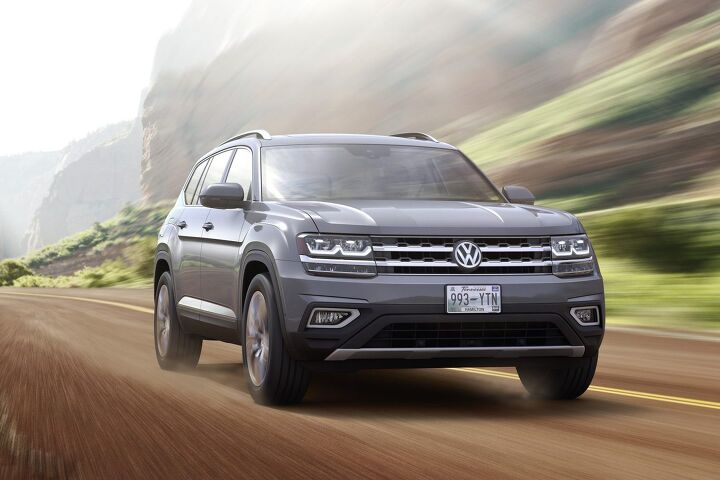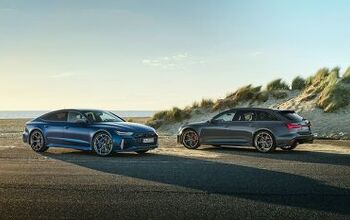Volkswagen Design Employee Claims Atlas Styling Boring, Old, Domestic

There’s no doubt Volkswagen needs its new midsize Atlas to be a home run (or, at least, a ground rule double) to keep its American dealers appeased following the now-year-long diesel emissions scandal. Even before the scandal, Volkswagen USA could neither create a product mix befitting American sensibilities nor price its ill-marketed product at price points palatable to the American public.
Yet, Atlas — Volkswagen’s crossover slotting between the compact Tiguan and upmarket Touareg — wears sheetmetal penned by Ativan-popping designers, and one of Volkswagen’s design employees agrees.
At the Los Angeles Auto Show, I had a chance encounter with an employee of Volkswagen responsible for part of the company’s design process. As we sat together, I queried him on the Atlas’ design from a designer’s perspective.
The answers were equal parts shocking and expected.
When asked about how much the Atlas excites him from a visual standpoint, the employee stated, “It’s boring. Of course it’s boring.”
Prodded further, the person stated, “That vehicle is four years old. And by that, I mean it looks four years old.”
However, the comparison with another make drove the point home.
“It looks like a 2012 Ford whatever. It could be anything.”
The Atlas, in addition to the Golf Alltrack, is part of Volkswagen’s plan to rebrand the automaker from a purveyor of efficient diesels to an expert in all-wheel-drive capability and its associated Subaru-esque lifestyle.
In the future, Atlas derivatives could have additional wheelbase lengths and sport seating for five instead of the current seven. A partially electrified model is also in the cards.
Two engines will power the Atlas at launch: a 2.0-liter turbocharged four-cylinder producing 238 horsepower, and the company’s VR6 3.6-liter V6 engine with 280 hp. Both will be mated to an eight-speed automatic sending power to just front or all four wheels via Volkswagen’s 4Motion all wheel drive system.
The design, unfortunately, is standard equipment.
[Image: Volkswagen of America]

More by Mark Stevenson
Latest Car Reviews
Read moreLatest Product Reviews
Read moreRecent Comments
- AZFelix UCHOTD (Used Corporate Headquarters of the Day):Loaded 1977 model with all the options including tinted glass windows, People [s]Mugger[/s] Mover stop, and a rotating restaurant. A/C blows cold and it has an aftermarket Muzak stereo system. Current company ran okay when it was parked here. Minor dents and scrapes but no known major structural or accident damage. Used for street track racing in the 80s and 90s. Needs some cosmetic work and atrium plants need weeding & watering – I have the tools and fertilizer but haven’t gotten around to doing the work myself. Rare one of a kind design. No trades or low ball offers – I know what I got.
- El scotto UH, more parking and a building that was designed for CAT 5 cable at the new place?
- Ajla Maybe drag radials? 🤔
- FreedMike Apparently this car, which doesn't comply to U.S. regs, is in Nogales, Mexico. What could possibly go wrong with this transaction?
- El scotto Under NAFTA II or the USMCA basically the US and Canada do all the designing, planning, and high tech work and high skilled work. Mexico does all the medium-skilled work.Your favorite vehicle that has an Assembled in Mexico label may actually cross the border several times. High tech stuff is installed in the US, medium tech stuff gets done in Mexico, then the vehicle goes back across the border for more high tech stuff the back to Mexico for some nuts n bolts stuff.All of the vehicle manufacturers pass parts and vehicles between factories and countries. It's thought out, it's planned, it's coordinated and they all do it.Northern Mexico consists of a few big towns controlled by a few families. Those families already have deals with Texan and American companies that can truck their products back and forth over the border. The Chinese are the last to show up at the party. They're getting the worst land, the worst factories, and the worst employees. All the good stuff and people have been taken care of in the above paragraph.Lastly, the Chinese will have to make their parts in Mexico or the US or Canada. If not, they have to pay tariffs. High tariffs. It's all for one and one for all under the USMCA.Now evil El Scotto is thinking of the fusion of Chinese and Mexican cuisine and some darn good beer.

































Comments
Join the conversation
It looks like a facelifted Dacia Duster. Perhaps Volkswagen should slap a Skoda emblem on it? JK.
Gillette calls copyright infringement. Normally I like how Dubs look, but this looks sharp as in slice your finger off.